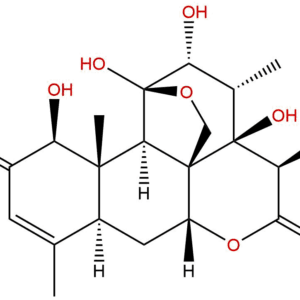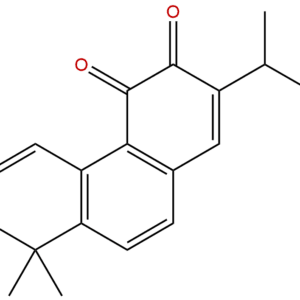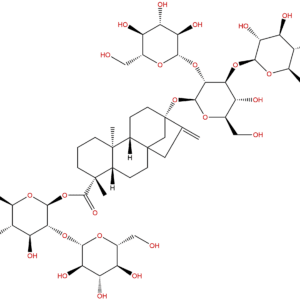$40.00 – $96.00
| CAS No.: | 64849-39-4 |
| Molecular Formula | C₃₂H₅₀O₁₃ |
| Molecular Weight | 642.7g/mol |
| Purity | HPLC>98% |
| Chemical Family | Diterpenoids |
* Warning: BIORLAB’s Natural Compounds are for laboratory research purposes only.
Rubusoside is a naturally occurring diterpene glycoside extracted primarily from the leaves of Rubus suavissimus S. Lee (Chinese sweet tea, Tian Cha), a plant native to southern China and traditionally used as a natural sweetener and medicinal herb. BIORLAB offers high-purity rubusoside (≥98%) isolated through advanced extraction and purification technologies. This compound has gained significant attention for its potent sweetening properties (approximately 115 times sweeter than sucrose), solubilizing capabilities, and diverse pharmacological activities, making it valuable for food science research, pharmaceutical development, and natural product chemistry.
IUPAC Name: [(2S,3R,4S,5S,6R)-3,4,5-trihydroxy-6-(hydroxymethyl)oxan-2-yl] (1R,4S,5R,9S,10R,13S)-5,9-dimethyl-14-methylidene-13-[(2S,3R,4S,5S,6R)-3,4,5-trihydroxy-6-(hydroxymethyl)oxan-2-yl]oxytetracyclo[11.2.1.01,10.04,9]hexadecane-5-carboxylate
InChI: InChI=1S/C32H50O13/c1-15-11-31-9-5-18-29(2,7-4-8-30(18,3)28(41)44-26-24(39)22(37)20(35)16(12-33)42-26)19(31)6-10-32(15,14-31)45-27-25(40)23(38)21(36)17(13-34)43-27/h16-27,33-40H,1,4-14H2,2-3H3/t16-,17-,18+,19+,20-,21-,22+,23+,24-,25-,26+,27+,29-,30-,31-,32+/m1/s1
InChIKey: YWPVROCHNBYFTP-OSHKXICASA-N
Canonical SMILES: CC12CCCC(C1CCC34C2CCC(C3)(C(=C)C4)OC5C(C(C(C(O5)CO)O)O)O)(C)C(=O)OC6C(C(C(C(O6)CO)O)O)O
Isomeric SMILES: C[C@@]12CCC[C@@]([C@H]1CC[C@]34[C@H]2CC[C@](C3)(C(=C)C4)O[C@H]5[C@@H]([C@H]([C@@H]([C@H](O5)CO)O)O)O)(C)C(=O)O[C@H]6[C@@H]([C@H]([C@@H]([C@H](O6)CO)O)O)O
Synonyms: Rubusoside; 64849-39-4; TCV5K3M3GX; Kaur-16-en-18-oic acid, 13-(beta-D-glucopyranosyloxy)-, beta-D-glucopyranosyl ester, (4alpha)-; 1-O-[(8alpha,9beta,10alpha,13alpha)-13-(beta-D-glucopyranosyloxy)-18-oxokaur-16-en-18-yl]-beta-D-glucopyranose; UNII-TCV5K3M3GX; Rubusoside?; Kaur-16-en-18-oic acid, 13-(ss-D-glucopyranosyloxy)-, ss-D-glucopyranosyl ester, (4a)-; 1H-2,10a-Ethanophenanthrene, kaur-16-en-18-oic acid deriv.; Rubusoside; …
Botanical Source: Hydrangea strigosa Rehd.
BIORLAB’s rubusoside undergoes:
For research use only. Not for human consumption or clinical use. All BIORLAB natural compounds are intended solely for laboratory research applications.
For detailed specifications, bulk quantities, or technical support, please contact BIORLAB’s scientific team.
BIORLAB commits to excellence and reliability.
Your orders are shipped seamlessly between countries
You have the right to return your orders within 30 days.
Your payments are secure with our private security network.




For you to better choose the right compounds, and so the scientific research can be carried out smoothly, here are some FAQs.
Delivery times vary based on order size, We deliver small quantities of compounds within 2 working days, ranging from one week for up to 500 compounds to about 6 weeks for orders exceeding 5,000 compounds.
While our focus is on natural compounds, we can provide information on natural product-like synthetic compounds if requested.
Yes, we provide comprehensive analytical data and certificates of analysis for all our compounds.
Yes, we can re-supply active compounds in larger quantities and offer analogs for further testing if hits are discovered.
We offer a wide range of natural compounds including alkaloids, terpenoids, flavonoids, coumarins, peptides, glycosides, and nucleosides isolated from plants.
Our compounds undergo rigorous purification processes and are tested using advanced analytical methods such as NMR, mass spectroscopy, and in some cases, X-ray analysis to ensure >98% purity.
Yes, we offer custom isolation services for specific natural compounds based on client requirements.
We typically offer quantities ranging from 2 mg to 100 mg for screening purposes, with larger amounts available upon request.
We use various physicochemical analytical methods, including NMR (300-500 MHz) and mass spectroscopy, to confirm structures and stereochemistry.
BIORLAB is committed to providing highly competitive natural compounds and comprehensive solutions to customers around the world.






Get The Latest Updates and Promotion Information.
